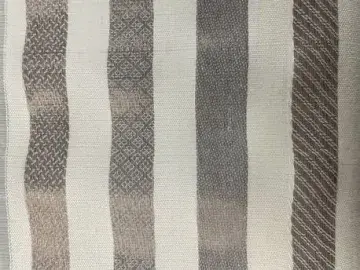Fabric woven to harness solar power recently completed weaving trials. The fabric will ultimately be used to design high-functioning gear that can keep responders’ tech charged and ready.
Shining Solution
Millions of American homes are powered by solar panels, capturing light shining down from above and converting it into electricity. Solar power is a well-established energy resource with enormous potential and countless applications—perhaps limited only by our imaginations. Good thing imagination is an endlessly renewable resource for the Science and Technology Directorate (S&T).
The idea of clothing that can capture sunlight and turn it into electricity may sound like something out of science fiction, but S&T is working to make it a reality. Photovoltaic (PV) energy harvesting fabric is not only possible, but also a practical solution to a persistent challenge. First responders need light-weight power sources for their sensors, and other body-worn electronic devices. Energy harvesting fabric mitigates risk associated with relying solely on wall outlets to charge equipment. For instance, during a natural disaster and emergency response, the power grids may be compromised. The fabric also eliminates the need to carry extra batteries.
“Smart textiles are the future,” said S&T Program Manager Kimberli Jones-Holt. “This energy harvesting fabric project is incredibly innovative. I’ve been so impressed by the ingenuity of the research team and I look forward to the day that first responders are wearing and benefitting from this product.”
A Stitch in Time

The First Responder Resource Group initially identified this capability as a high-priority need, and S&T listened. The solution in development now involves creating a PV fiber that can be woven into a power fabric and then integrated onto first responder garments, shelters, and related equipment to provide reliable power for charging batteries to power electronics. The power output of the fabric will be sufficient to charge AA batteries in eight hours. This effort will provide the foundational framework towards the development of commercially viable, textile-integrated, energy-harvesting PV devices that can be tested for direct application in the field.
S&T awarded $199,260 to Boston-based company Protect the Force, LLC, in August 2018 to initiate this work through the Silicon Valley Innovation Program. The University of Massachusetts Lowell (UML) is also partnering on this important project through its world-class Fabric Discovery Center. Together, the team of industry, academic, and S&T experts created an initial prototype fabric with fibers containing an incredibly thin light harvesting coating on smooth stainless-steel wire core that measures only a few hundred nanometers. This allowed the team to successfully demonstrate the proof of concept at small scale (100 cm2 fabric swatch) in July 2019 and then move on to the next phase of development.
Work in Progress
“This is innovation in real-time,” said Francisco Martinez, Vice President to the Chief Technology Officer at Protect the Force, LLC. “This is a new technology, so the manufacturing equipment doesn’t exist yet. We’re constantly adjusting and improving to come up with a product that works and can be scaled up.”

A key testament to the team’s real-time ingenuity and problem-solving is the way they have been able to adapt and reconfigure their equipment. Their curing process is a prime example of this. They needed an ultraviolet lamp to cure the wire cladding since uncured wire is sticky and thus hard to work with. (Cladding is the application of protective layers for insulation.) Working at the cutting-edge of technology meant there was nothing commercially available for their purposes. The team was able to identify UV curable cladding material and the appropriate UV lamp to ensure uniform, even curing of the wire—and subsequent quality and reliability of the woven fabric.
A Bright Future
Phase II includes initial production, testing of the PV energy harvesting fabric swatches, and demonstration of integration onto a firefighter garment. While the initial application is planned for wildland firefighting, S&T is exploring compelling opportunities to transition the technology to other Department of Homeland Security agencies and beyond.
“What we learn during this process can be used for a lot of other things,” added Dr. Ramaswamy Nagarajan, UML Engineering Professor and Co-Director of the Center for Advanced Materials’ Harnessing Emerging Research Opportunities to Empower Soldiers (HEROES) program. “We need to get this right to enable future applications.”

In the Spring of 2022, UML successfully conducted weaving trials. The team integrated the PV nanofibers with hundreds of feet of Nomex® yarn, a flame-resistant textile used in protective apparel, using a Thread Controller 2 digital loom.
Design optimization is now currently underway. Developers are working on weaving designs for the textile fibers that maximizes exposure to the sun and thus creates peak energy output from the fabric. They are experimenting with various patterns including twill, satin, dobby, and broken twill.
Flexibility and water repellence are other very important factors, and both depend upon proper cladding. Developers will also test resistance to various stressors to ensure compliance with National Fire Protection Association standards and work to make the fabric breathable, which has proven to be a significant scientific challenge.
The project will conclude later this year with the completion of Phase II. “The work that has been done to this point will be used to help determine additional interest from the first responder community for this type of technology,” explained Jones-Holt. “The task will closeout with the development of energy harvesting fabric woven into a first responder garment.”
Learn more about energy harvesting fabric on our website and contact STMedia@hq.dhs.gov with related media inquiries.
